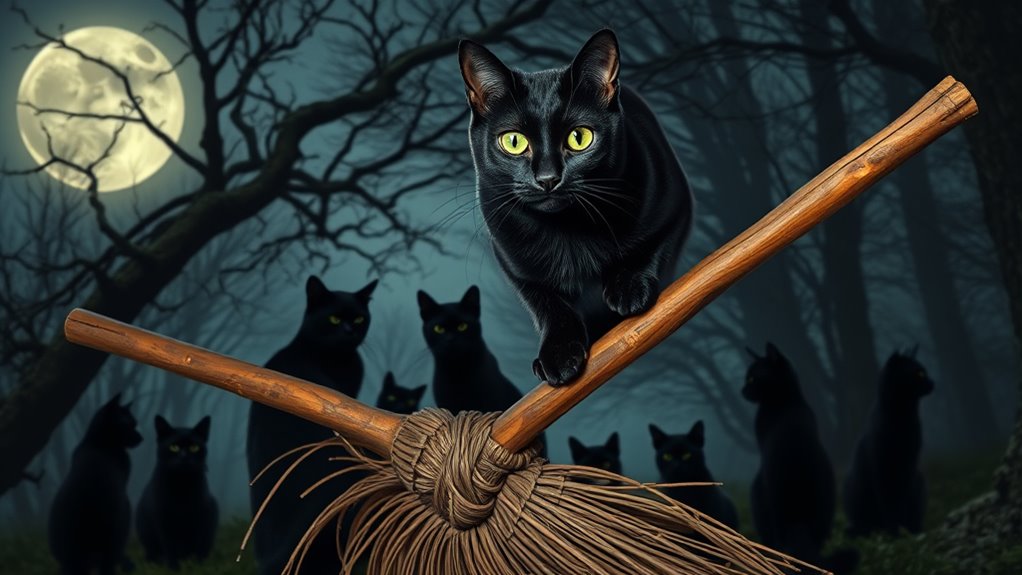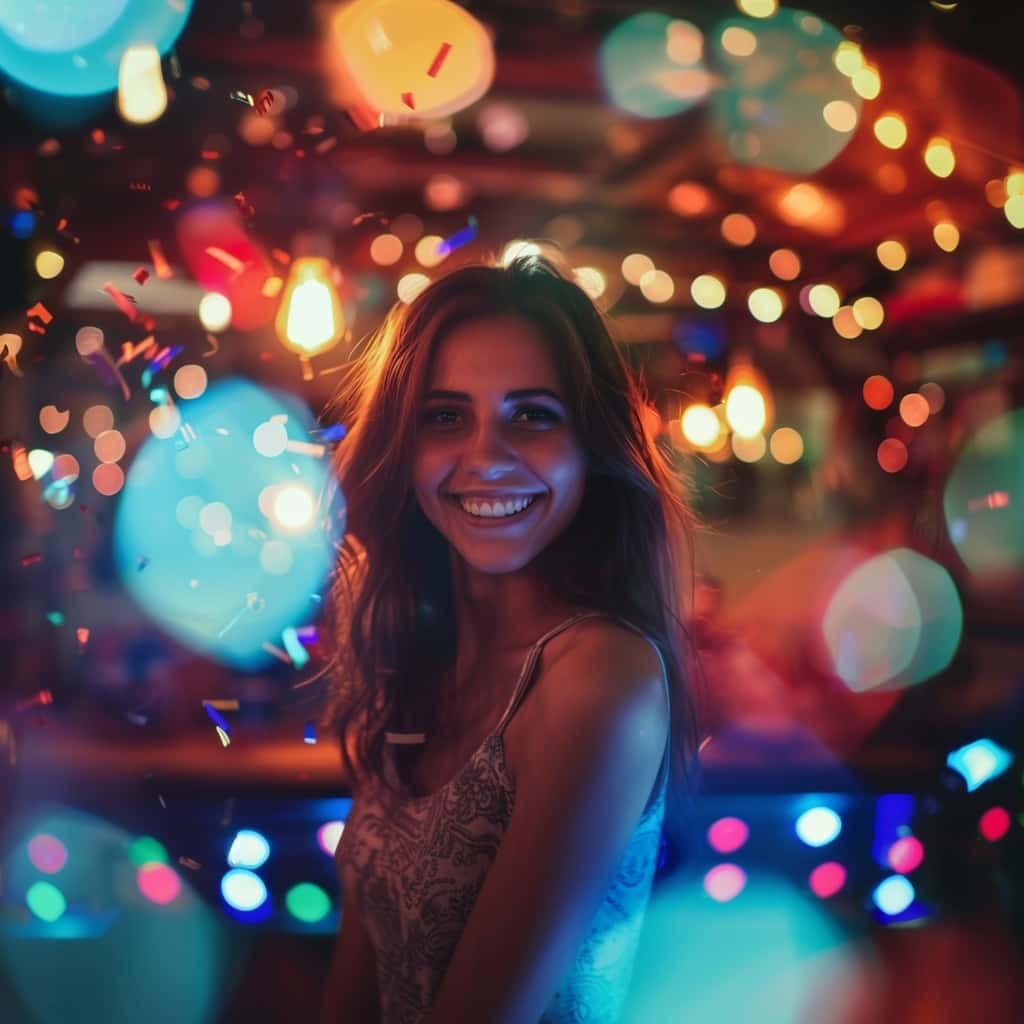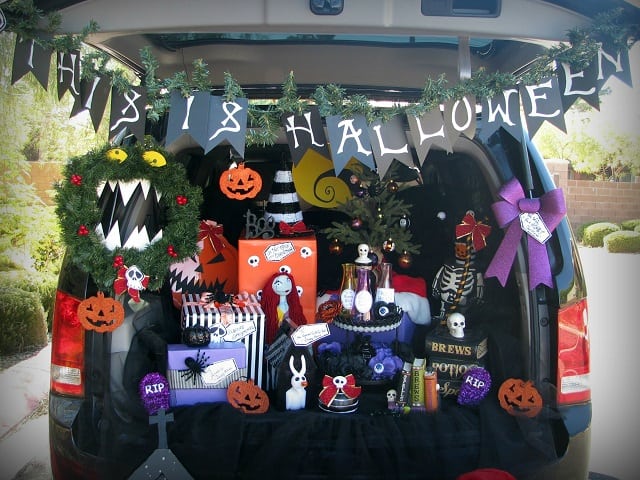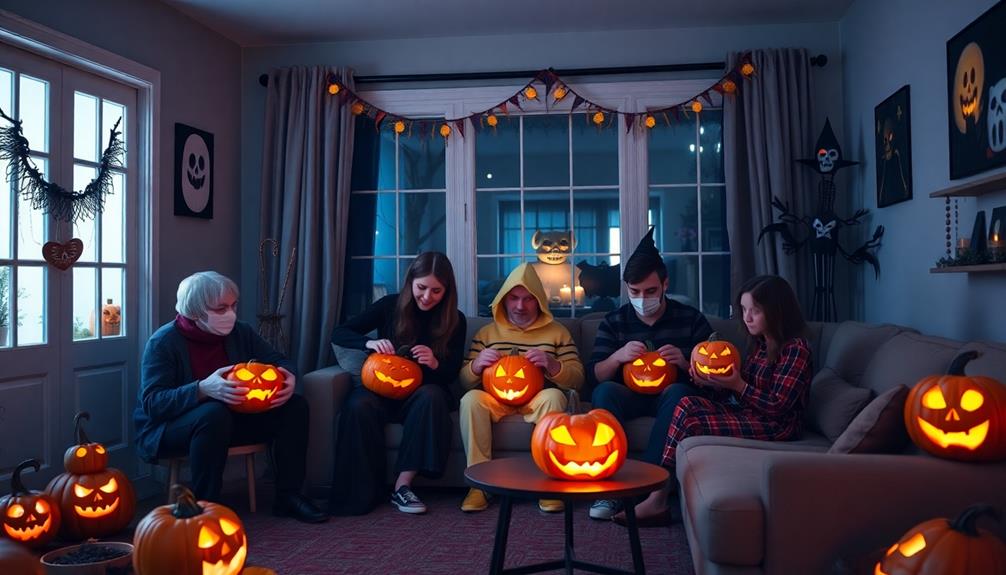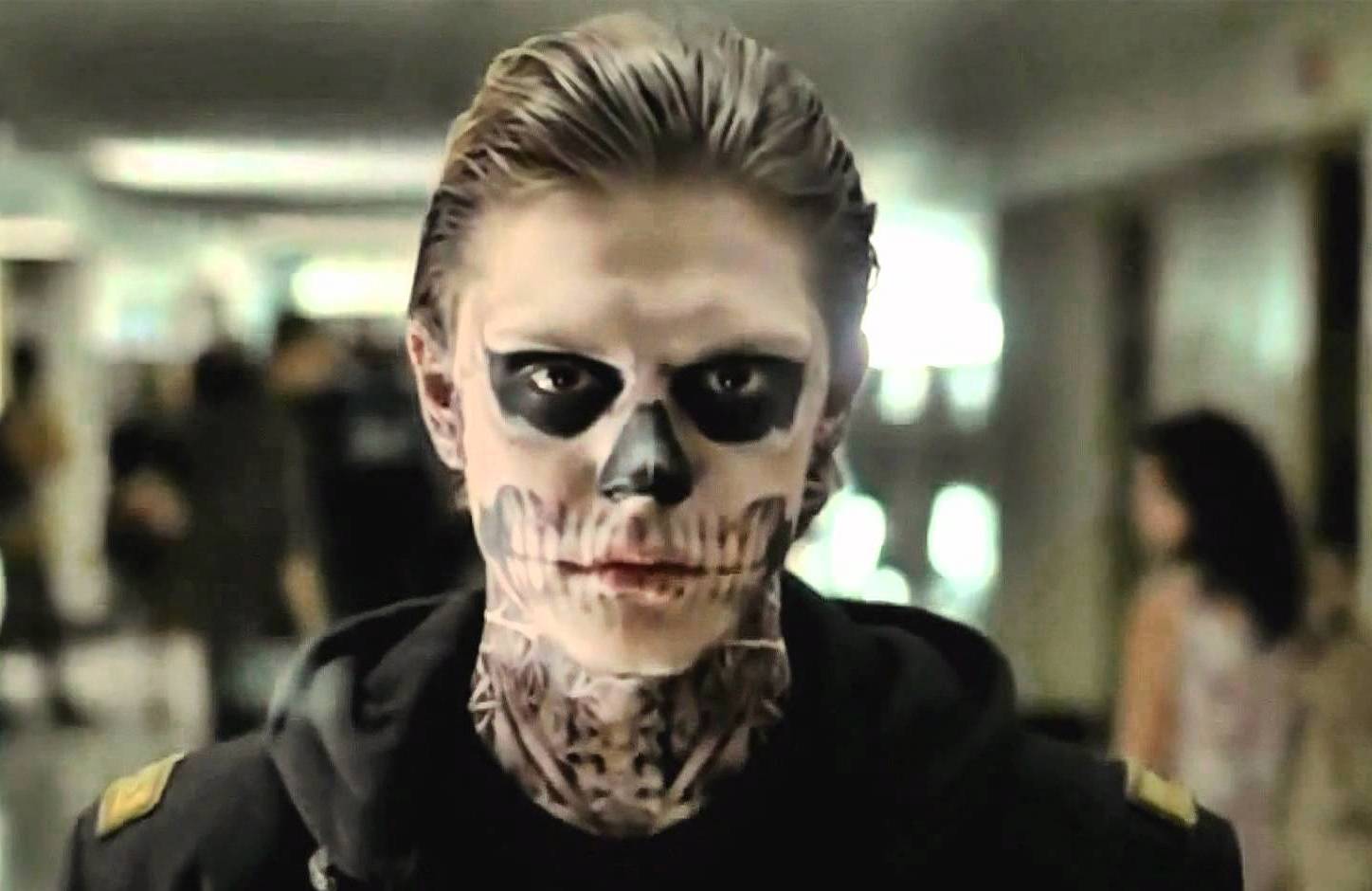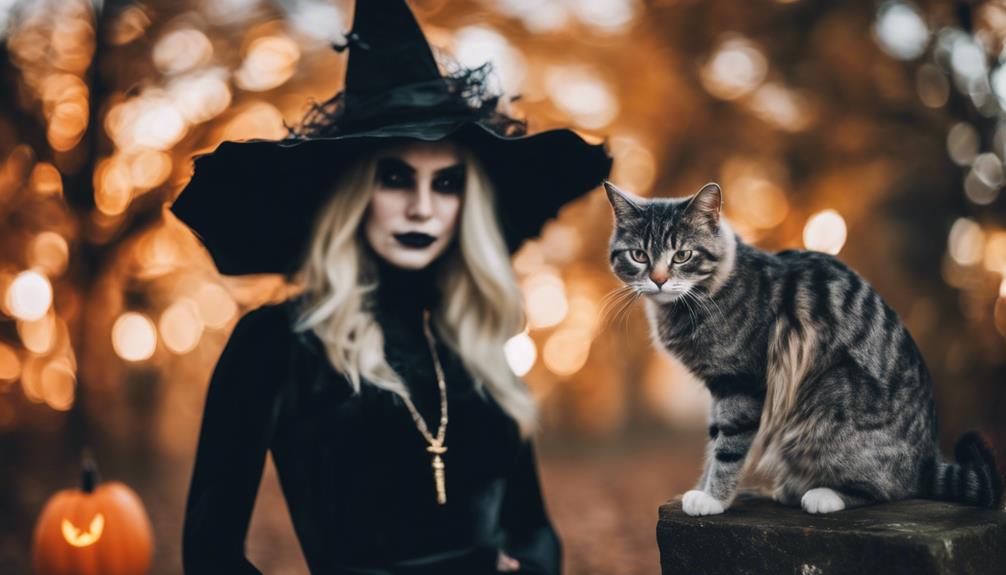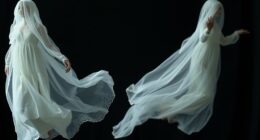Black cats and broomsticks are deeply rooted in folklore, often linked to superstition and witchcraft. While black cats symbolize mystery and protection in some cultures, others see them as omens of misfortune, especially during witch hunts. Broomsticks traditionally symbolized magic and flight, evolving into icons of mysticism and celebration. To separate fact from fiction, it’s helpful to explore their true history and cultural meanings. Discover more about these fascinating symbols and their evolution as you continue.
Key Takeaways
- Black cats have historically been linked to superstition, witchcraft, and misfortune, especially during medieval witch hunts.
- Broomsticks originated as practical tools but became symbols of magic, flight, and protection in folklore and popular culture.
- Myth and media often portray black cats as omens of bad luck, though scientifically they are regular cats with melanistic fur.
- Cultural perceptions of black cats vary globally, with some symbols of prosperity and others associated with evil or misfortune.
- Modern celebrations reframe black cats and broomsticks as symbols of mystery, magic, and empowerment, shifting from superstition to festivity.
The Historical Roots of Black Cats in Folklore

Black cats have long been associated with superstition and mystery, dating back centuries across various cultures. During medieval persecution, black cats often became victims of fear and misunderstandings, linked to witchcraft and evil. Feline symbolism played a significant role in this era, as cats were seen as companions of witches or even as witches themselves in disguise. These beliefs fueled the superstition that black cats brought bad luck or malevolent energy. Throughout history, societies viewed black cats with suspicion, often associating them with dark magic. Their mysterious nature, combined with these cultural fears, cemented their reputation as symbols of the supernatural. The association between black cats and witchcraft was further reinforced by their mysterious behavior, which many cultures interpreted as signs of supernatural involvement. Understanding this historical context helps clarify why black cats remain intertwined with folklore and superstition today.
Broomsticks: From Practical Tools to Symbolic Symbols
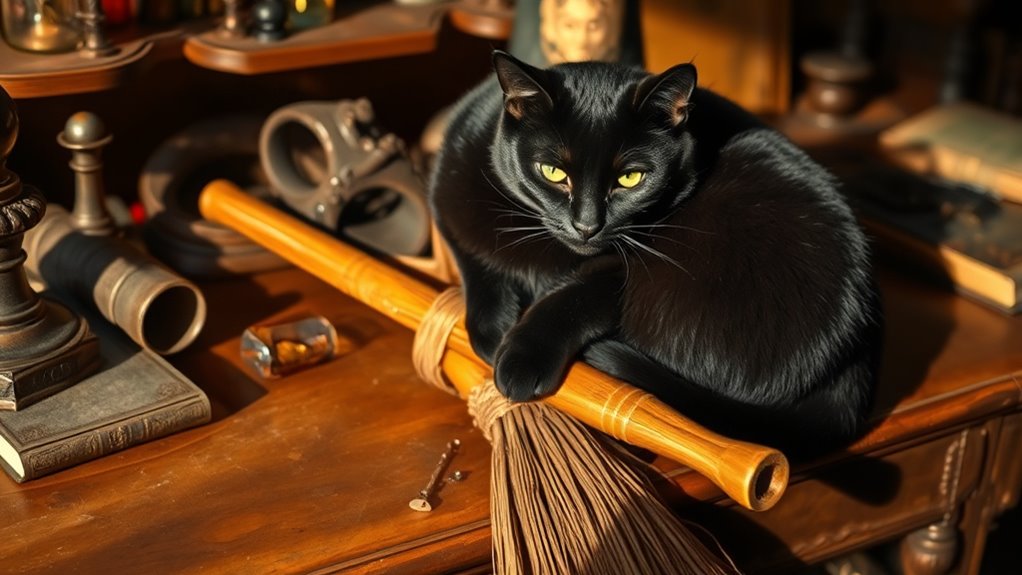
Although broomsticks were originally simple cleaning tools used in households, over time they have transformed into powerful symbols of magic and witchcraft. In witchcraft history, broomsticks became associated with ritual practices, representing the ability to ward off evil spirits or invoke protection. Folklore symbolism links broomsticks to flight, freedom, and mystical journeys, often depicted as flying mounts for witches. This shift from practical tool to spiritual emblem reflects societal fears and reverence for the supernatural. The image of a witch riding a broomstick has endured through centuries, reinforcing its place in popular culture. Today, broomsticks symbolize not just practicality but also the mystical and transformative aspects of witchcraft, bridging everyday life with the enchanted domain of folklore. Additionally, cultural symbolism continues to evolve, demonstrating how objects can acquire layered meanings over time.
The Superstitions Surrounding Black Cats Around the World

Across different cultures, black cats are seen in many ways, from symbols of bad luck to bringers of good fortune. You might be surprised how their meanings change depending on where you are. These superstitions reveal a fascinating mix of beliefs around the world. Developing a Cultural Intelligence about these varied perceptions can help us better understand the cultural nuances behind such superstitions.
Cultural Interpretations Vary
Around the world, black cats are seen through vastly different lenses, shaping beliefs and superstitions that influence how people treat them. In some cultures, they embody cosmic symbolism, representing mystery, protection, or even good fortune. For example, in parts of Asia, black cats are considered symbols of prosperity, and their presence can bring luck. Conversely, in certain European traditions, they are linked to witchcraft and misfortune. Culinary traditions also reflect these varied views; in some regions, black cats are associated with Halloween festivities, reinforcing spooky superstitions, while elsewhere, they’re respected as sacred or protective animals. These cultural differences highlight how perceptions of black cats are deeply rooted in local history, beliefs, and customs, shaping attitudes that range from reverence to suspicion. Additionally, in some cultures, unique and wicked planters are used in folklore and rituals involving black cats, further emphasizing their complex symbolism.
Symbols of Good Luck
Have you ever wondered why black cats are considered lucky in some cultures? Their mythical symbolism often portrays them as protectors and bringers of good fortune. In parts of the UK and Japan, black cats are seen as omens of prosperity, believed to ward off evil spirits and attract positive energy. Cultural representations reinforce this idea, depicting black cats as symbols of luck rather than misfortune. This contrasts sharply with superstitions elsewhere, where they’re linked to witchcraft and bad luck. In these cultures, black cats embody a dual nature—sometimes feared, sometimes revered. Their role as symbols of good luck highlights how perception varies, shaped by historical myths and cultural stories that influence how people interpret these mysterious creatures. Understanding the cultural significance of black cats can help clarify why they are viewed differently across societies.
Common Superstitions Worldwide
Superstitions about black cats vary dramatically from one culture to another, shaping how people react to these animals. In some places, urban legends portray black cats as symbols of bad luck or witchcraft, often stemming from myth origins linked to medieval Europe’s fears of witches and sorcery. Conversely, in other regions like the UK and Japan, black cats are considered good luck, believed to bring prosperity or ward off evil spirits. These differing superstitions influence your reactions—you might avoid or cherish black cats based on local beliefs. Understanding these cultural variations helps you see that superstitions are shaped by history and myth origins, not facts. Recognizing the diverse attitudes towards black cats reveals how folklore can evolve and impact perceptions worldwide. Additionally, the superstitions surrounding black cats have persisted through generations, influencing modern attitudes and behaviors.
Origins of the Witch and Black Cat Connection

The deep-rooted connection between witches and black cats dates back centuries, and understanding its origins reveals how these creatures became symbols of the supernatural. Black cat symbolism is closely tied to fears of witchcraft, where black cats were believed to be witches’ familiars or shape-shifted witches themselves. Historically, during the witch hunts, black cats were often seen as accomplices in dark rituals. Additionally, the broomstick history plays a role: witches were believed to use broomsticks for flight, and black cats often appeared alongside them, reinforcing the link. To summarize:
- Black cats were thought to be witches’ familiars, protecting or spying on them.
- They symbolized mystery and the supernatural in folklore.
- Their pairing with broomsticks solidified their association with witchcraft practices.
- Ongoing research into AI safety measures highlights how myth and modern technology both involve addressing hidden risks and misconceptions.
The Evolution of Broomstick Symbolism in Popular Culture
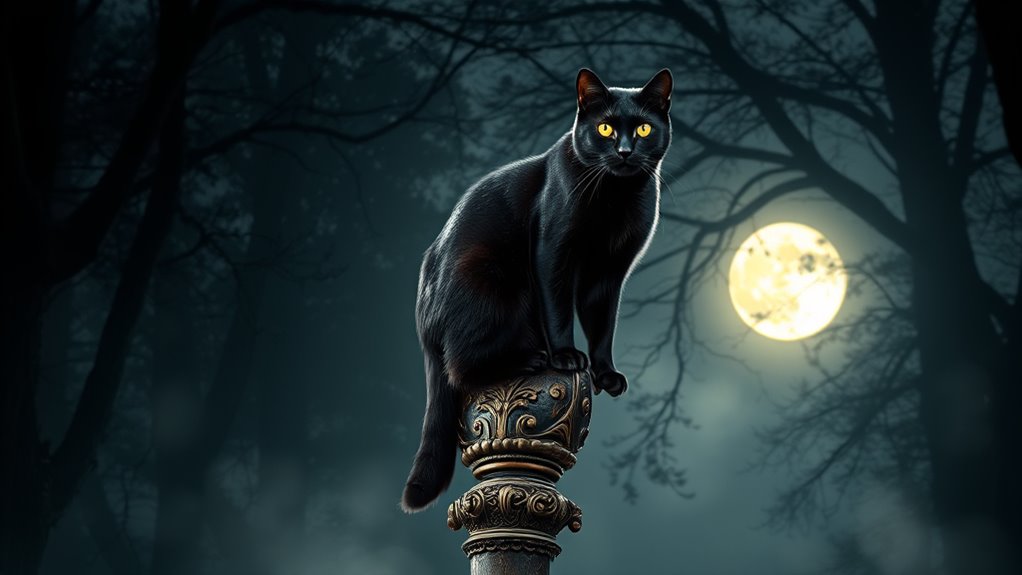
As the association between black cats and witches became ingrained in folklore, the image of the broomstick also evolved into a powerful symbol within popular culture. Over time, broomsticks transformed from practical tools into iconic witchcraft symbols, representing magic, freedom, and mystery. This folklore evolution was fueled by literature, film, and art, which romanticized the image of witches flying on broomsticks. You’ll notice this symbolism in Halloween celebrations, where broomsticks are everyday props. They symbolize not just witchcraft but also rebellion against societal norms. The transformation reflects how folklore shapes cultural perceptions, turning simple objects into enduring symbols that embody myths, fears, and fantasies about witchcraft through history and media.
Debunking Common Myths About Black Cats and Witchcraft
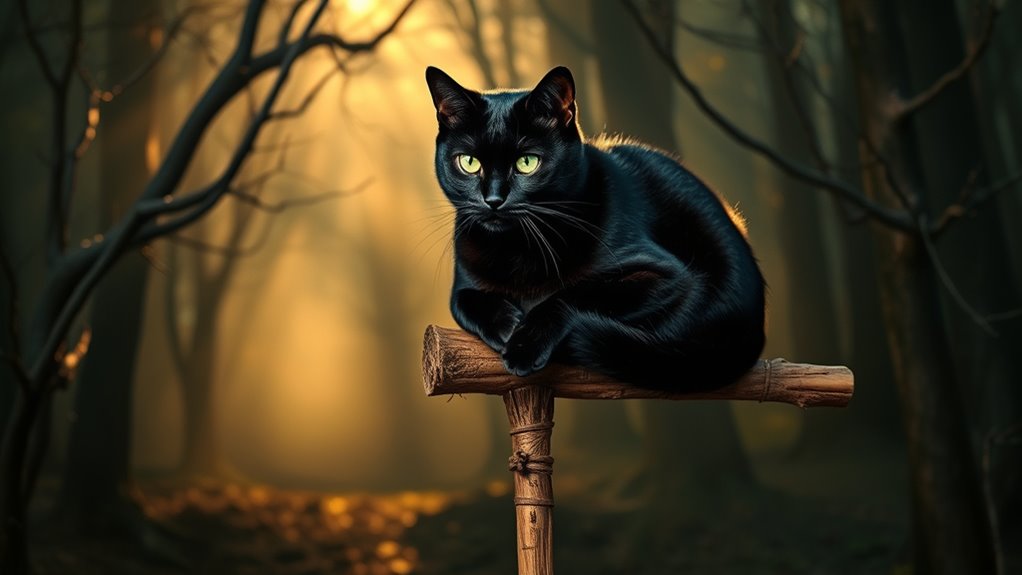
Many of the myths linking black cats to witchcraft are based on misconceptions rather than facts. In witchcraft history and folklore origins, black cats were often seen as omens or familiars of witches, fueling superstitions. To debunk these myths:
- Black cats are not inherently witches’ favorites; they are simply a common pet in many cultures.
- The idea that black cats bring bad luck is a superstition rooted in folklore, not reality.
- Historically, during witch hunts, black cats were falsely accused of being witches in disguise, but this has no basis in fact.
- Recognizing the cultural significance of black cats helps dispel harmful stereotypes and promotes kindness toward these animals.
Understanding the true history helps clarify that black cats are innocent creatures often misunderstood through folklore origins that have persisted over time.
How Folklore Influences Modern Attitudes Toward Black Cats

You might notice that many people still see black cats through the lens of old superstitions, which shape their attitudes today. Media stories and movies often reinforce the idea that black cats bring bad luck or magic, even if it’s not true. Understanding these influences helps you see how folklore continues to affect perceptions now.
Historical Superstitions Impact
Historical superstitions have long shaped how people perceive black cats, often casting them as symbols of misfortune or witchcraft. These beliefs influence your attitudes by linking folklore origins to cat behavior and superstition. For example:
- Black cats crossing your path were believed to bring bad luck.
- Superstitions grew from myths about witches transforming into cats to avoid detection.
- Folklore origins suggested black cats were omens of death or evil spirits.
These ideas persisted, affecting modern views of black cats, especially around Halloween. Despite evidence showing black cats are just as loving and playful as other cats, these superstitions still influence your perceptions today. Recognizing the roots of these beliefs helps you separate fact from folklore, encouraging a more positive attitude toward black cats.
Media’s Role in Perception
Have you ever wondered how movies, TV shows, and stories shape your views of black cats today? Media influence plays a significant role in perception shaping, often reinforcing superstitions that associate black cats with bad luck or witchcraft. These portrayals influence public attitudes, making many see black cats as symbols of misfortune. Consider the table below, which shows common media themes:
| Theme | Example | Impact on Perception |
|---|---|---|
| Evil omens | Witchcraft in movies | Reinforces negative stereotypes |
| Lucky symbols | Black cats as good luck in stories | Challenges superstitions with positive views |
| Mystical creatures | Black cats as mysterious beings | Sparks curiosity, but also fear |
This cycle of media influence continues to shape modern attitudes, blending folklore with popular culture. Additionally, media portrayal often lacks context, which can distort perceptions further.
The Science Behind Black Cat Myths and Superstitions

Many black cat myths and superstitions stem from misconceptions rooted in centuries-old beliefs and cultural biases. These ideas often ignore the science behind animal behavior and genetic traits. Black cats are simply animals with dark fur caused by specific genetic traits. Their behavior is no different from other cats, driven by instincts and environment. To understand the myths better, consider these points:
- Black fur results from a genetic trait called melanism, not any supernatural influence.
- Animal behavior studies show black cats act just like cats of any other color.
- Cultural biases, not any real danger, fueled superstitions linking black cats to bad luck or witchcraft.
- Recognizing the genetic basis of black fur can help dispel many of these outdated superstitions.
Knowing the science helps you see black cats as ordinary animals, not symbols of superstition.
Celebrating Black Cats and Broomsticks in Contemporary Culture
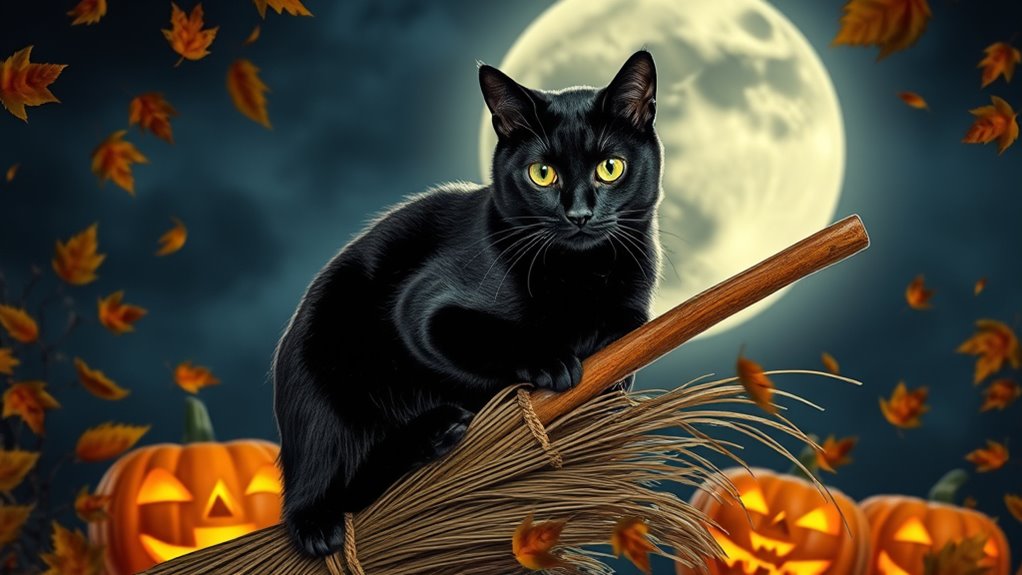
Today, black cats and broomsticks have become symbols of celebration rather than superstition. People embrace black cat symbolism for its association with mystery and magic, especially during Halloween. Broomstick legends inspire costumes and decorations that honor witchcraft traditions. Many communities host events that highlight these symbols as part of cultural festivities. Recognizing their shift from superstition to celebration helps you appreciate their cultural significance today. Additionally, the symbolism of black cats and broomsticks has evolved to emphasize positive qualities like protection and empowerment rather than fear.
Frequently Asked Questions
How Did Black Cats Become Symbols of Witchcraft Historically?
You might find it fascinating that black cats became symbols of witchcraft due to their historical symbolism and folklore origins. During the Middle Ages, people believed black cats were witches’ familiars, helping them cast spells. These superstitions grew, linking black cats to evil and magic. Over time, this folklore transformed into a cultural association, making black cats icons of witchcraft in stories, movies, and Halloween traditions.
Are There Any Real Origins of Broomsticks Used in Witchcraft Rituals?
Historical broom use in witchcraft likely originated from ritualistic broom symbolism, representing purification and spiritual cleansing. People believed witches used brooms to cast spells or summon spirits, often riding them in visions or ceremonies. Some historians think the broom’s handle symbolized a phallic object, emphasizing fertility rites. Today, these practices are part of folklore, but the roots of ritualistic broom symbolism trace back to ancient rituals of cleansing and protection.
What Are Some Modern Cultural Practices Celebrating Black Cats?
You celebrate black cats through various modern practices, like honoring Black Cat symbolism during Halloween or supporting their adoption in shelters. Many people see black cats as symbols of mystery and protection, embracing their unique charm. Modern pet adoption campaigns actively promote giving black cats loving homes, helping dispel myths and encouraging positive perceptions. By doing so, you help foster appreciation and compassion for these often misunderstood animals.
How Do Superstitions About Black Cats Vary Across Different Countries?
You might be surprised to learn that superstitions around black cats differ widely across countries. In the U.S. and UK, they’re often seen as bad luck, especially if they cross your path. Conversely, in Japan and parts of Scotland, black cats are considered good luck or symbols of protection. These cultural differences in black cat beliefs reveal how folklore evolves, shaping perceptions and influencing behaviors around these mysterious animals worldwide.
Can Black Cats Really Influence Luck or Superstition Today?
You might think black cats influence luck, but it’s mostly superstition myths rather than fact. Cat symbolism varies worldwide, with some cultures seeing black cats as good luck, while others see them as bad omens. Today, many people dismiss these superstitions, recognizing them as folklore rather than truth. So, if a black cat crosses your path, it’s up to you whether to see it as a sign or just a cat walking by.
Conclusion
As you can see, the tales of black cats and broomsticks are woven with history and myth. Don’t buy into every superstition you hear—sometimes, the truth is hiding in plain sight. By understanding their true origins, you’ll see they’re just as much a part of culture as they are misunderstood symbols. So, keep an open mind and remember, it’s often the legends that cast the longest shadows, not the facts.
